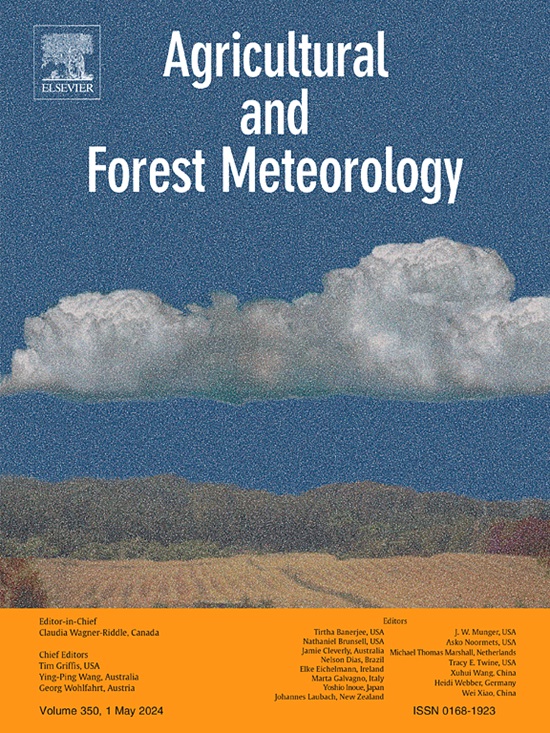低和中等火灾天气的频率减少可能是导致内华达山脉北部发生大规模野火的原因
IF 5.6
1区 农林科学
Q1 AGRONOMY
引用次数: 0
摘要
先前的分析发现,大规模的气候模式导致燃料更干旱,是最近整个加州野火活动急剧增加的驱动因素。这项研究重新审视了一种方法,以调查内华达山脉北部更多的当地火灾天气模式;该地区最近经历了异常频繁的野火活动。在1994年之前,每年超过90和95百分位能量释放分量(ERC)值的火季日数百分比非常低(图3)。自1994年以来,出现明显超标百分比(20%)的年份更为频繁。然而,最高和第二高的年度超标均发生在2012年之后。从20世纪90年代末和21世纪初开始,低于第80和第50百分位ERC阈值的火灾季节日数呈减少趋势。在整个研究期间,线性趋势线显示出强烈的负下降。这些下降最有可能的影响是对灭火的有效性,这依赖于低到中等的火灾天气来“取得进展”。也就是说,即使两种火灾天气条件的结合(高火天气日数增加,低火天气日数减少)也不能完全解释最近被烧毁面积的增加。其他的影响,如茂密的森林结构、更大的燃料连续性和点火(数量和时间)也可能起作用。本文章由计算机程序翻译,如有差异,请以英文原文为准。
Decreasing frequency of low and moderate fire weather days may be contributing to large wildfire occurrence in the northern Sierra Nevada
Previous analyses identified large-scale climatic patterns contributing to greater fuel aridity as drivers of recent dramatic increases in wildfire activity throughout California. This study revisits an approach to investigate more local fire weather patterns in the northern Sierra Nevada; a region within California that has experienced exceptionally high wildfire activity recently. The annual percentages of fire season days above 90th and 95th percentile Energy Release Component (ERC) values were very low prior to 1994 (Fig. 3). Since 1994, years with noticeable percentages of exceedances (>20 %) occurred more frequently. However, neither the highest nor second highest annual exceedances occurred after 2012. Starting in the late 1990s and early 2000s there was a decreasing trend in number of fire season days below the 80th and 50th percentile ERC thresholds. Linear trend lines indicated strongly negative declines throughout the study period. The most likely impact of these declines is on the effectiveness of fire suppression, which rely on low to moderate fire weather to “gain ground” on containment. That said, even the combination of both fire weather conditions (greater high fire weather days and lesser low fire weather days) provides an imperfect explanation for the recent increases in burned area. Additional influences, such as dense forest structures, greater fuel continuity, and ignitions (both number and timing of) are likely contributing as well.
求助全文
通过发布文献求助,成功后即可免费获取论文全文。
去求助
来源期刊
CiteScore
10.30
自引率
9.70%
发文量
415
审稿时长
69 days
期刊介绍:
Agricultural and Forest Meteorology is an international journal for the publication of original articles and reviews on the inter-relationship between meteorology, agriculture, forestry, and natural ecosystems. Emphasis is on basic and applied scientific research relevant to practical problems in the field of plant and soil sciences, ecology and biogeochemistry as affected by weather as well as climate variability and change. Theoretical models should be tested against experimental data. Articles must appeal to an international audience. Special issues devoted to single topics are also published.
Typical topics include canopy micrometeorology (e.g. canopy radiation transfer, turbulence near the ground, evapotranspiration, energy balance, fluxes of trace gases), micrometeorological instrumentation (e.g., sensors for trace gases, flux measurement instruments, radiation measurement techniques), aerobiology (e.g. the dispersion of pollen, spores, insects and pesticides), biometeorology (e.g. the effect of weather and climate on plant distribution, crop yield, water-use efficiency, and plant phenology), forest-fire/weather interactions, and feedbacks from vegetation to weather and the climate system.

 求助内容:
求助内容: 应助结果提醒方式:
应助结果提醒方式:


